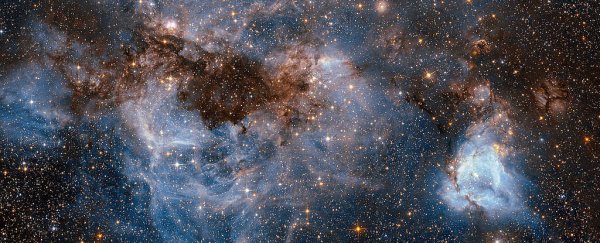There's an enemy in our midst. Quietly circling around our galaxy, it could send our Solar System hurtling out of the Milky Way and into the obscurity of interstellar space.
Its name is the Large Magellanic Cloud (LMC), and even though it is one of the more researched satellite galaxies buzzing around our own, astrophysicists are only now seeing it for what it truly is: an unusually large cosmic threat.
New research predicts that the LMC is doomed to collide with our own galaxy, and it's coming far sooner than we thought.
On the off chance that humans survive for another two billion years, our descendants will be in for a treat.
If the catastrophic collision wakes up the black hole sleeping at the center of our galaxy, this dark beast will begin devouring everything in sight, growing ten times larger than it already is.
As it feeds on surrounding gas, the stage will be set and the show will begin - what the researchers describe as a "spectacular display of cosmic fireworks."
"This phenomenon will generate powerful jets of high energy radiation emanating from just outside the black hole," explains lead author Marius Cautun, a cosmologist at Durham University.
"While this will not affect our Solar System, there is a small chance that we might not escape unscathed from the collision between the two galaxies which could knock us out of the Milky Way and into interstellar space."
Two billion years may seem like a long way off, but it's actually quite short on cosmic timescales. It's also six billion years sooner than the predicted impact between the Milky Way and our closest neighbouring galaxy, Andromeda.
Our galaxy is long overdue for such a collision. So far, it has managed to get by relatively unscathed in the grand scheme of things. Especially when you consider the company that it keeps.
The Milky Way is surrounded by a group of smaller satellite galaxies, orbiting quietly around us.
These galaxies can lead separate lives for many billions of years, but on occasion, they can find themselves sinking into the centre of their host galaxy, until at last they collide and are swallowed up completely.
In this way, galaxies are constantly evolving and growing, but the Milky Way's poor appetite makes it quite atypical.
In comparison to our own galaxy, for instance, Andromeda can devour galaxies weighing nearly 30 times more.
"We think that up to now our galaxy has had only a few mergers with very low mass galaxies," says co-author Alis Deason, a computational cosmologist at Durham University.
"This represents very slim pickings when compared to nearby galaxies of the same size as the Milky Way."
The LMC will be our first meal in a while. Even though it only moved into our neighbourhood about 1.5 billion years ago, it has crept unnervingly close, sitting 163,000 light-years away from our galaxy - less than a tenth of the distance to Andromeda.
Astronomers used to think it would circle quietly around us for many more billions of years, maybe even escaping from our galaxy's gravitational pull altogether.
But recent measurements suggest it has nearly twice as much dark matter as we bargained on.
Considering this larger-than-expected mass, the researchers say the LMC is rapidly losing energy. And as it slows down, it won't be able to escape our galaxy's clutches.
"The destruction of the Large Magellanic Cloud, as it is devoured by the Milky Way, will wreak havoc with our galaxy, waking up the black hole that lives at its centre and turning our galaxy into an 'active galactic nucleus' or quasar," says Cautun.
So much for keeping your enemies closer.
This study has been published by The Royal Astronomical Society.
